18/09 - 07/09, 2009
-
Kutlug Ataman
Dictionary
Curated by Maurizio Bortolotti
Dictionary, the exhibition of Kutlug Ataman – one of the foremost contemporary Turkish artists – is the second of the series called Insight Turkey, curated by Maurizio Bortolotti for Francesca Minini after Obstructions (2008), dedicated to the work of Ali Kazma.
To be opened on 18 September 2009, the show will present part of Ataman’s new project Mesopotamian Dramaturgies, focused on the question of language in the era of globalization.
Ataman uses the medium of the video to create projects and installations which explore the Turkish social scene, stressing the contradictions between this and the approved lifestyle imposed on the most technologically advanced countries by globalization. Such as the video dedicated to the Turkish opera singer Seminha Berksoy or Küba, a video installation in which we hear the stories of 40 inhabitants of a community living in a shantytown near Istanbul airport. Their tales reconstruct the personal and emotional reality of human relationships and create a social and emotive stratum which overlies that of the dire poverty in which they live. One of the chief questions tackled by the Mesopotamian Dramaturgies series is the meeting between tradition and modernity, their reciprocal attraction and the traumatic results of this encounter. The incongruities between modernization and the Turkish tradition, within which is rooted the identity of Europe, are at the basis of the artist’s work and express the idea of modernity in a very original manner.
Dictionary deals with the use of language as the chief form of communication in the age of globalization, and especially the ways in which communicability and incommunicability have become key features of our everyday experience.
English as a Second Language looks at the matter the other way round. In this video two young Turks who don’t know English read Edward Lear’s Nonsense Rhymes aloud. The problem of lack of communication here becomes even more evident because the text starts off as being nonsense. In this work the apparent clarity of language shows to what extent globalization creates a vast amount of nonsense for those of other languages and cultures.
The fact of globalization forces Ataman to a continual self-examination and an exploration of Turkish identity, in a search for the universality of values of European culture situated at the crossroads of East and West. In this sense present-day Turkey is an ideal stage on which all these contradictions appear, as contrasted with the illusory universality of globalization.
Images are also language, and the origin of this in modern times is to be found in photography. The manifesto for the exhibition shows Frame, a lightbox of a photograph taken in Turkey at the beginning of the 20th century, showing a group of soldiers. The way the photographer framed the shot defies the Renaissance idea of space to set the figures in a Byzantine hierarchical composition. It is this hybrid quality of the meeting between western culture represented by the modernity of photography and the Byzantine culture of the photographer himself that once again gives rise to a meditation on the misunderstandings of language.
The route followed by Dictionary ends with the video installation Strange Space. Shot in a desert area in eastern Turkey, the video shows the artist walking blindfold around and enormous expanse. It is the story of the hero who in the throes of passion goes seeking for his loved one. In this case also, blindness expresses the idea of inability to communicate, since seeing is at the very root of visual language. The artist gives expression to the metaphor of the present-day situation by walking on the brink of a chasm. This video is a prophecy of what modern life will be in a globalized world.
Kutlug Ataman’s project Mesopotamian Dramaturgies, consisting of eight works, will be presented with a solo show at the MAXXI_Museo nazionale delle arti del XXI secolo in Rome, on the occasion of the opening of the new museum in the spring of 2010. The curator of the exhibition will be Cristiana Perrella. It will be produced in collaboration with the UniCredit Group, which will purchase one of the works for the collection of the museum.
Dictionary, the exhibition of Kutlug Ataman – one of the foremost contemporary Turkish artists – is the second of the series called Insight Turkey, curated by Maurizio Bortolotti for Francesca Minini after Obstructions (2008), dedicated to the work of Ali Kazma.
To be opened on 18 September 2009, the show will present part of Ataman’s new project Mesopotamian Dramaturgies, focused on the question of language in the era of globalization.
Ataman uses the medium of the video to create projects and installations which explore the Turkish social scene, stressing the contradictions between this and the approved lifestyle imposed on the most technologically advanced countries by globalization. Such as the video dedicated to the Turkish opera singer Seminha Berksoy or Küba, a video installation in which we hear the stories of 40 inhabitants of a community living in a shantytown near Istanbul airport. Their tales reconstruct the personal and emotional reality of human relationships and create a social and emotive stratum which overlies that of the dire poverty in which they live. One of the chief questions tackled by the Mesopotamian Dramaturgies series is the meeting between tradition and modernity, their reciprocal attraction and the traumatic results of this encounter. The incongruities between modernization and the Turkish tradition, within which is rooted the identity of Europe, are at the basis of the artist’s work and express the idea of modernity in a very original manner.
Dictionary deals with the use of language as the chief form of communication in the age of globalization, and especially the ways in which communicability and incommunicability have become key features of our everyday experience.
English as a Second Language looks at the matter the other way round. In this video two young Turks who don’t know English read Edward Lear’s Nonsense Rhymes aloud. The problem of lack of communication here becomes even more evident because the text starts off as being nonsense. In this work the apparent clarity of language shows to what extent globalization creates a vast amount of nonsense for those of other languages and cultures.
The fact of globalization forces Ataman to a continual self-examination and an exploration of Turkish identity, in a search for the universality of values of European culture situated at the crossroads of East and West. In this sense present-day Turkey is an ideal stage on which all these contradictions appear, as contrasted with the illusory universality of globalization.
Images are also language, and the origin of this in modern times is to be found in photography. The manifesto for the exhibition shows Frame, a lightbox of a photograph taken in Turkey at the beginning of the 20th century, showing a group of soldiers. The way the photographer framed the shot defies the Renaissance idea of space to set the figures in a Byzantine hierarchical composition. It is this hybrid quality of the meeting between western culture represented by the modernity of photography and the Byzantine culture of the photographer himself that once again gives rise to a meditation on the misunderstandings of language.
The route followed by Dictionary ends with the video installation Strange Space. Shot in a desert area in eastern Turkey, the video shows the artist walking blindfold around and enormous expanse. It is the story of the hero who in the throes of passion goes seeking for his loved one. In this case also, blindness expresses the idea of inability to communicate, since seeing is at the very root of visual language. The artist gives expression to the metaphor of the present-day situation by walking on the brink of a chasm. This video is a prophecy of what modern life will be in a globalized world.
Kutlug Ataman’s project Mesopotamian Dramaturgies, consisting of eight works, will be presented with a solo show at the MAXXI_Museo nazionale delle arti del XXI secolo in Rome, on the occasion of the opening of the new museum in the spring of 2010. The curator of the exhibition will be Cristiana Perrella. It will be produced in collaboration with the UniCredit Group, which will purchase one of the works for the collection of the museum.
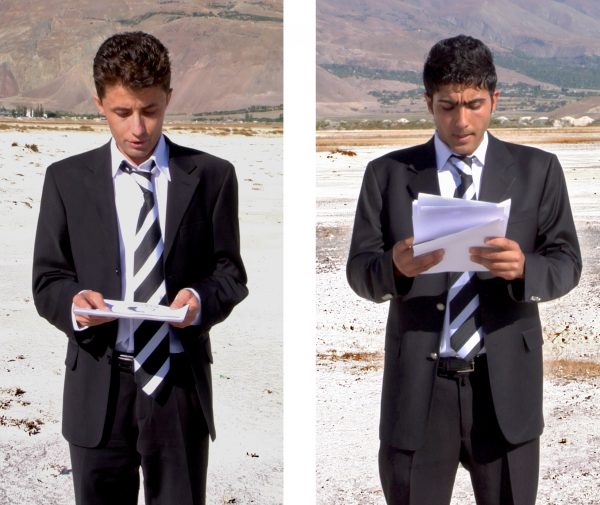 English as a Second Language, 20092 screens
English as a Second Language, 20092 screens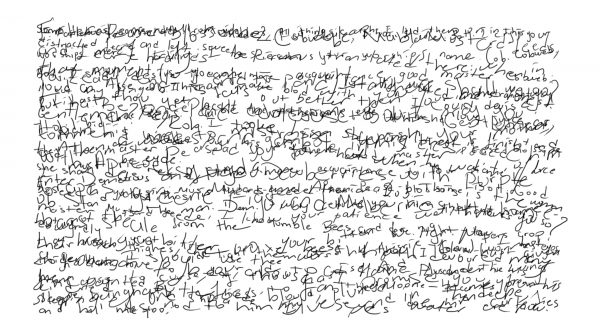 The Complete Works of William Shakespeare, 2009Single channel video
The Complete Works of William Shakespeare, 2009Single channel video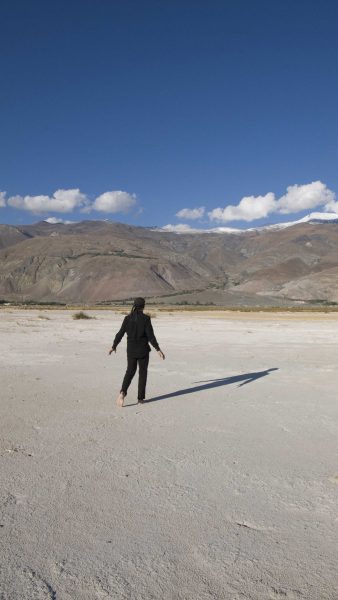 Strange Space, 2009Single channel video
Strange Space, 2009Single channel video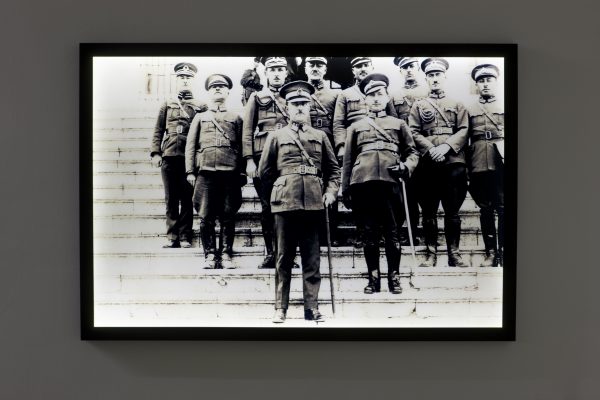 Frame, 2009Backlit still photo
Frame, 2009Backlit still photo
129×191×5 cm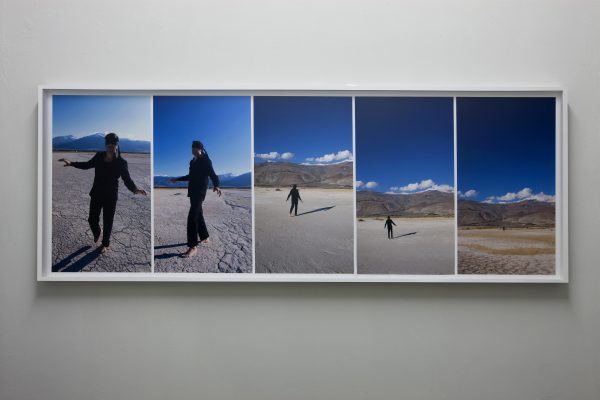 Strange Space, 2009
Strange Space, 2009
Still Photography
77×208 cm, 70x39,38 cm each, 5 parts



















